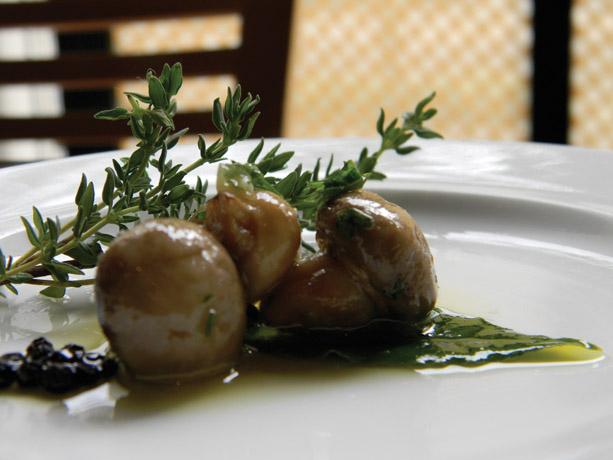Across the Cutting Board with Ris: Come Rain, Come mushrooms
By • May 3, 2012 0 1627

.
.
.
.
.
.
.
.
.
.
.
.
.
.
.
.
.
A rainy September can be bad news for the late summer harvest. With the cooler temperature and reduced sunlight, late summer favorites like cucumbers, heirloom tomatoes, melons and squash are quick to be damaged and waterlogged by abundant rainfall such that Hurricane Irene brought us. “But it didn’t just rain this month,” says farmer Mark Toigo. “It got biblical.”
Toigo is owner of Toigo Orchards, a local family farm in Shippensburg, Pa., and loyal supplier to chef and restaurateur Ris Lacoste. You can find Toigo Orchards’ produce at almost every major farmer’s market in the Washington area, and their selection is still among the best available despite the tough season. “It’s been a traumatic environmental cycle this year,” says Toigo. “The spring started off so wet, the soil so soggy, that we had late plantings. We had hale in late May. And July was a scorcher—over 90 degrees every day. We lost 10 percent of new tree plantings because we weren’t able to get enough water to the young roots.”
And after the heat, of course, came the rain.
“We easily lost $40,000 because of Irene,” says Jaci Arnold, of Richfield Farm in Manchester, Md. “We had significant crop loss and went out of service for a week. You can’t exactly go veggie picking in a hurricane.”
Plant cells expand and burst with excess water, Arnold explains, causing the vegetables to grow beyond their natural size, splitting, cracking and exploding. Consumers will feel the effects of this watery overkill into October, as the past month of rain drastically damaged this season’s pumpkin supply. Without proper drainage, even hearty, fully formed root vegetables will rot in a matter of days. Surviving vegetables spoil much faster; they often can’t even make it to the produce stands and tend to have a very limited shelf life.
However, nature always has a certain way of balancing itself out. With the excess rain, a few seasonal treats are thriving. “Brussel sprouts seem to be doing great,” says Arnold. “This rain came at a good time of their growth. And beet growth has also been accelerated. They can handle the water.”
And one bulbous little fungus is soaking up this wet September happier than the rest. Mushrooms are sprouting in beds across forest floors up and down the East Coast.
They’re hard to miss these days, squatting under trees, against shrubs and among the grass, their caps tilted pensively toward the cloudy skies. But this newspaper does not condone the picking and eating of wild mushrooms unless you are a fungal expert. So I, for one, adhere to Thoreau’s assessment of these exotic sprouts: “The value … is not in the mere possession or eating of them, but in the sight and enjoyment of them.”
“The mushrooms loved Irene,” says Ray Lasala, president of the Mycological Assocation of Washington. “Mushrooms are 90 percent water, and they appear a few days after the rain. They’re like compressed little sponges that develop in the ground and tree logs and pop when they’re hit with enough moisture.”
Lasala says that the best time of year for local fall mushrooms is between Labor Day and Columbus Day, when the moisture levels and temperature are right. Keep an eye out at the markets over the next few weeks for honey mushrooms, chicken of the woods and puffballs. Ris certainly will.
“Mushrooms are on the horizon,” she says, “along with pears, apples and winter squash. It’s a funny thing — I don’t want to give up summer, the peaches, tomatoes and corn. But fall is upon us, and a chef’s job is to always look ahead for what’s to come.”
Ris tips for cooking with mushrooms:
Make sure they are clean.
Make sure they are thoroughly dried.
Do not rinse mushrooms with gills, just dust them thoroughly with a towel or mushroom brush. The gills will absorb the water and dilute the mushroom.
Trim woody stems.
When cooking, start with a hot pan and a little bit of oil to seize moisture and caramelize.
Do not crowd the pan, only a single layer of mushrooms at a time. Overcrowding results in poached mushrooms, not seared.
Roasting is a great alternative to stir-frying. Toss with olive oil salt and pepper. Add shallots or herbs if you want.
Cook different types of mushrooms separately, as they each have different textures and require different cooking times. Mix after cooking.
Sherry and Madeira are two of my favorite wines for mushroom cooking.
Jed’s Marinated Mushrooms
by Sous Chef Jed Fox
3 oz. canola oil
1 lb. cleaned and trimmed mushrooms,
any variety
6 Tbs. chopped garlic
6 Tbs. chopped shallots
2 sprigs thyme
1 fresh bay leaf
Salt and white pepper
2 oz. dry white wine
Good olive oil
Bring the canola oil to smoking hot in a large, heavy based saucepan. Add mushrooms in a single layer, covering the bottom of the pan. Stir once and allow to sear for 3 – 4 minutes, until golden brown. Stir again and allow to brown 4 – 5 minutes longer. Add garlic, shallots, herbs, salt and pepper to taste. Cook until shallots are soft and aromatics are released. Deglaze with the white wine. Reduce the wine to almost dry, then add olive oil just to cover. Bring the olive oil to a light simmer and remove pan from heat. Allow to rest for 15 minutes, until cool enough to handle. Pour into a storage container and keep covered in the refrigerator for up to ten days. Allow mushrooms to return to room temperature before serving. NOTE: The mushroom oil can also be used as a lovely finishing oil for pastas and salads.

